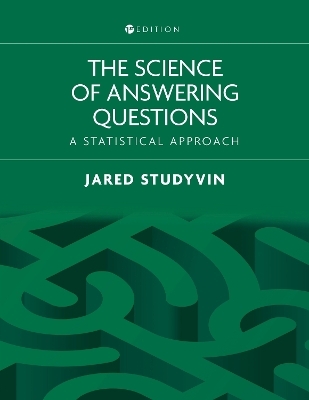
The Science of Answering Questions
A Statistical Approach
Seiten
2023
Cognella, Inc (Verlag)
9781793582508 (ISBN)
Cognella, Inc (Verlag)
9781793582508 (ISBN)
Introduces students to the process of determining an answer to a question or problem through the collection of information, the use of statistical tools on the information, and reaching a conclusion based on the results.
The Science of Answering Questions: A Statistical Approach introduces students to the process of determining an answer to a question or problem through the collection of information, the use of statistical tools on the information, and reaching a conclusion based on the results.
Opening chapters explore the evidence needed to answer the question of interest. Students learn about variables, levels of measurement, populations, samples, and sampling, as well as commonly used and freely available statistical software that can be used in statistical analyses. Additional chapters introduce ways to display and describe information collected from the sample, including summaries, summary tables, and graphs. Descriptive statistics and inferential statistics are covered. Readers explore descriptors, predictors, point estimation, deviation and variance, probability distributions, and interval estimation. Chapters in the latter half of the text focus on answering different questions of interest or the same question with different types of collected information. These chapters cover hypothesis testing, one sample proportion, multinomial, pre-post, homogeneity, correlation, independence, and more. Appendices provide students with helpful references related to critical values and standard normal probabilities.
Providing students with a complete yet accessible introduction, The Science of Answering Questions is an excellent introductory resource for a course in statistics.
The Science of Answering Questions: A Statistical Approach introduces students to the process of determining an answer to a question or problem through the collection of information, the use of statistical tools on the information, and reaching a conclusion based on the results.
Opening chapters explore the evidence needed to answer the question of interest. Students learn about variables, levels of measurement, populations, samples, and sampling, as well as commonly used and freely available statistical software that can be used in statistical analyses. Additional chapters introduce ways to display and describe information collected from the sample, including summaries, summary tables, and graphs. Descriptive statistics and inferential statistics are covered. Readers explore descriptors, predictors, point estimation, deviation and variance, probability distributions, and interval estimation. Chapters in the latter half of the text focus on answering different questions of interest or the same question with different types of collected information. These chapters cover hypothesis testing, one sample proportion, multinomial, pre-post, homogeneity, correlation, independence, and more. Appendices provide students with helpful references related to critical values and standard normal probabilities.
Providing students with a complete yet accessible introduction, The Science of Answering Questions is an excellent introductory resource for a course in statistics.
Jared Studyvin holds a Ph.D. in statistics and is a faculty member in the Department of Mathematics and Statistics at the University of Wyoming.
| Erscheinungsdatum | 11.07.2023 |
|---|---|
| Verlagsort | San Diego |
| Sprache | englisch |
| Maße | 152 x 229 mm |
| Themenwelt | Mathematik / Informatik ► Mathematik |
| Sozialwissenschaften ► Soziologie ► Empirische Sozialforschung | |
| ISBN-13 | 9781793582508 / 9781793582508 |
| Zustand | Neuware |
| Informationen gemäß Produktsicherheitsverordnung (GPSR) | |
| Haben Sie eine Frage zum Produkt? |
Mehr entdecken
aus dem Bereich
aus dem Bereich
Buch | Hardcover (2023)
De Gruyter Oldenbourg (Verlag)
CHF 48,90
ein Arbeitsbuch
Buch | Softcover (2021)
De Gruyter Oldenbourg (Verlag)
CHF 48,90
Buch | Hardcover (2022)
Springer VS (Verlag)
CHF 209,95


